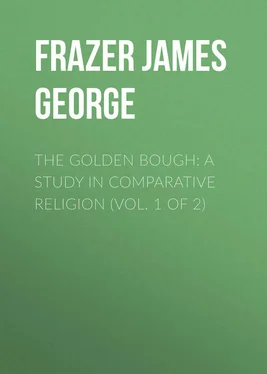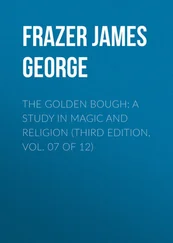James Frazer - The Golden Bough - A Study in Comparative Religion (Vol. 1 of 2)
Здесь есть возможность читать онлайн «James Frazer - The Golden Bough - A Study in Comparative Religion (Vol. 1 of 2)» — ознакомительный отрывок электронной книги совершенно бесплатно, а после прочтения отрывка купить полную версию. В некоторых случаях можно слушать аудио, скачать через торрент в формате fb2 и присутствует краткое содержание. Жанр: foreign_religion, foreign_antique, foreign_prose, на английском языке. Описание произведения, (предисловие) а так же отзывы посетителей доступны на портале библиотеки ЛибКат.
- Название:The Golden Bough: A Study in Comparative Religion (Vol. 1 of 2)
- Автор:
- Жанр:
- Год:неизвестен
- ISBN:нет данных
- Рейтинг книги:4 / 5. Голосов: 1
-
Избранное:Добавить в избранное
- Отзывы:
-
Ваша оценка:
- 80
- 1
- 2
- 3
- 4
- 5
The Golden Bough: A Study in Comparative Religion (Vol. 1 of 2): краткое содержание, описание и аннотация
Предлагаем к чтению аннотацию, описание, краткое содержание или предисловие (зависит от того, что написал сам автор книги «The Golden Bough: A Study in Comparative Religion (Vol. 1 of 2)»). Если вы не нашли необходимую информацию о книге — напишите в комментариях, мы постараемся отыскать её.
The Golden Bough: A Study in Comparative Religion (Vol. 1 of 2) — читать онлайн ознакомительный отрывок
Ниже представлен текст книги, разбитый по страницам. Система сохранения места последней прочитанной страницы, позволяет с удобством читать онлайн бесплатно книгу «The Golden Bough: A Study in Comparative Religion (Vol. 1 of 2)», без необходимости каждый раз заново искать на чём Вы остановились. Поставьте закладку, и сможете в любой момент перейти на страницу, на которой закончили чтение.
Интервал:
Закладка:
In return the Kings of Fire and Water sent him a huge wax candle and two calabashes, one full of rice and the other of sesame. The candle bore the impress of the Fire King's middle finger. Probably the candle was thought to contain the seed of fire, which the Cambodian monarch thus received once a year fresh from the Fire King himself. The holy candle was kept for sacred uses. On reaching the capital of Cambodia it was entrusted to the Brahmans, who laid it up beside the regalia, and with the wax made tapers which were burned on the altars on solemn days. As the candle was the special gift of the Fire King, we may conjecture that the rice and sesame were the special gift of the Water King. The latter was doubtless king of rain as well as of water, and the fruits of the earth were boons conferred by him on men. In times of calamity, as during plague, floods, and war, a little of this sacred rice and sesame was scattered on the ground “to appease the wrath of the maleficent spirits.” 192 192 J. Moura, Le Royaume du Cambodge , i. 432-436; Aymonier, “Notes sur les coutumes et croyances superstitieuses des Cambodgìens,” in Cochinchine Française, Excursions et Reconnaissances , No. 16, p. 172 sq. ; id. , Notes sur le Laos , p. 60.
These, then, are examples of what I have called departmental kings of nature. But it is a far cry to Italy from the forests of Cambodia and the sources of the Nile. And though Kings of Rain, Water and Fire have been found, we have still to discover a King of the Wood to match the Arician priest who bore that title. Perhaps we shall find him nearer home.
§ 4. – Tree-worship
In the religious history of the Aryan race in Europe the worship of trees has played an important part. Nothing could be more natural. For at the dawn of history Europe was covered with immense primeval forests, in which the scattered clearings must have appeared like islets in an ocean of green. Down to the first century before our era the Hercynian forest stretched eastward from the Rhine for a distance at once vast and unknown; Germans whom Caesar questioned had travelled for two months through it without reaching the end. 193 193 Caesar, Bell. Gall. vi. 25.
In our own country the wealds of Kent, Surrey, and Sussex are remnants of the great forest of Anderida, which once clothed the whole of the south eastern portion of the island. Westward it seems to have stretched till it joined another forest that extended from Hampshire to Devon. In the reign of Henry II the citizens of London still hunted the wild bull and the boar in the forest of Hampstead. Even under the later Plantagenets the royal forests were sixty-eight in number. In the forest of Arden it was said that down to modern times a squirrel might leap from tree to tree for nearly the whole length of Warwickshire. 194 194 Elton, Origins of English History , pp. 3, 106 sq. , 224.
The excavation of prehistoric pile-villages in the valley of the Po has shown that long before the rise and probably the foundation of Rome the north of Italy was covered with dense forests of elms, chestnuts, and especially of oaks. 195 195 W. Helbig, Die Italiker in der Poebene , p. 25 sq.
Archaeology is here confirmed by history; for classical writers contain many references to Italian forests which have now disappeared. 196 196 H. Nissen, Italische Landeskunde , p. 431 sqq.
In Greece the woods of the present day are a mere fraction of those which clothed great tracts in antiquity, and which at a more remote epoch may have spanned the Greek peninsula from sea to sea. 197 197 Neumann und Partsch, Physikalische Geographie von Griechenland , p. 357 sqq.
From an examination of the Teutonic words for “temple” Grimm has made it probable that amongst the Germans the oldest sanctuaries were natural woods. 198 198 Grimm, Deutsche Mythologie , 4 i. 53 sqq.
However this may be, tree-worship is well attested for all the great European families of the Aryan stock. Amongst the Celts the oak-worship of the Druids is familiar to every one. 199 199 The locus classicus is Pliny, Nat. Hist. xvi. § 249 sqq.
Sacred groves were common among the ancient Germans, and tree-worship is hardly extinct amongst their descendants at the present day. 200 200 Grimm, D. M. i. 56 sqq.
At Upsala, the old religious capital of Sweden, there was a sacred grove in which every tree was regarded as divine. 201 201 Adam of Bremen, Descriptio Insul. Aquil. p. 27.
Amongst the ancient Prussians (a Slavonian people) the central feature of religion was the reverence for the sacred oaks, of which the chief stood at Romove, tended by a hierarchy of priests who kept up a perpetual fire of oak-wood in the holy grove. 202 202 “Prisca antiquorum Prutenorum religio,” in Respublica sive Status Regni Poloniae, Lituaniae, Prussiae, Livoniae , etc. (Elzevir, 1627), p. 321 sq. ; Dusburg, Chronicon Prussiae , ed. Hartknoch, p. 79; Hartknoch, Alt- und Neues Preussen , p. 116 sqq.
The Lithuanians were not converted to Christianity till towards the close of the fourteenth century, and amongst them at the date of their conversion the worship of trees was prominent. 203 203 Mathias Michov, “De Sarmatia Asiana atque Europea,” in Novus Orbis regionum ac insularum veteribus incognitarum (Paris, 1532), pp. 455 sq. 456 [wrongly numbered 445, 446]; Martin Cromer, De origine et rebus gestis Polonorum (Basel, 1568), p. 241.
Proofs of the prevalence of tree-worship in ancient Greece and Italy are abundant. 204 204 See Bötticher, Der Baumkultus der Hellenen .
Nowhere, perhaps, in the ancient world was this antique form of religion better preserved than in the heart of the great metropolis itself. In the Forum, the busy centre of Roman life, the sacred fig-tree of Romulus was worshipped down to the days of the empire, and the withering of its trunk was enough to spread consternation through the city. 205 205 Pliny, Nat. Hist. xv. § 77; Tacitus, Ann. xiii. 58.
Again, on the slope of the Palatine Hill grew a cornel-tree which was esteemed one of the most sacred objects in Rome. Whenever the tree appeared to a passer-by to be drooping, he set up a hue and cry which was echoed by the people in the street, and soon a crowd might be seen running from all sides with buckets of water, as if (says Plutarch) they were hastening to put out a fire. 206 206 Plutarch, Romulus , 20.
But it is necessary to examine in some detail the notions on which tree-worship is based. To the savage the world in general is animate, and trees are no exception to the rule. He thinks that they have souls like his own and he treats them accordingly. Thus the Wanika in Eastern Africa fancy that every tree and especially every cocoa-nut tree has its spirit: “the destruction of a cocoa-nut tree is regarded as equivalent to matricide, because that tree gives them life and nourishment, as a mother does her child.” 207 207 J. L. Krapf, Travels, Researches, and Missionary Labours during an Eighteen Years' Residence in Eastern Africa , p. 198.
Siamese monks, believing that there are souls everywhere and that to destroy anything whatever is forcibly to dispossess a soul, will not break a branch of a tree “as they will not break the arm of an innocent person.” 208 208 Loubere, Historical Relation of the Kingdom of Siam , p. 126.
These monks, of course, are Buddhists. But Buddhist animism is not a philosophical theory. It is simply a common savage dogma incorporated in the system of an historical religion. To suppose with Benfey and others that the theories of animism and transmigration current among rude peoples of Asia are derived from Buddhism is to reverse the facts. Buddhism in this respect borrowed from savagery, not savagery from Buddhism. Again, the Dyaks ascribe souls to trees and do not dare to cut down an old tree. In some places, when an old tree has been blown down, they set it up, smear it with blood, and deck it with flags “to appease the soul of the tree.” 209 209 Hupe “Over de godsdienst, zeden, enz. der Dajakker's” in Tijdschrift voor Neêrland's Indië , 1846, dl. iii. 158.
People in Congo place calabashes of palm-wine at the foot of certain trees for the trees to drink when they are thirsty. 210 210 Merolla, “Voyage to Congo,” in Pinkerton's Voyages and Travels , xvi. 236.
In India shrubs and trees are formally married to each other or to idols. 211 211 Monier Williams, Religious Life and Thought in India , p. 334 sq.
In the North West Provinces of India a marriage ceremony is performed in honour of a newly-planted orchard; a man holding the Salagram represents the bridegroom, and another holding the sacred Tulsi ( Ocymum sanctum ) represents the bride. 212 212 Sir Henry M. Elliot and J. Beames, Memoirs on the History etc. of the Races of the North Western Provinces of India , i. 233.
On Christmas Eve German peasants used to tie fruit-trees together with straw ropes to make them bear fruit, saying that the trees were thus married. 213 213 Die gestriegelte Rockenphilosophie (Chemnitz, 1759), p. 239 sq. ; U. Jahn, Die deutsche Opfergebräuche bei Ackerbau und Viehzucht , p. 214 sqq.
Интервал:
Закладка:
Похожие книги на «The Golden Bough: A Study in Comparative Religion (Vol. 1 of 2)»
Представляем Вашему вниманию похожие книги на «The Golden Bough: A Study in Comparative Religion (Vol. 1 of 2)» списком для выбора. Мы отобрали схожую по названию и смыслу литературу в надежде предоставить читателям больше вариантов отыскать новые, интересные, ещё непрочитанные произведения.
Обсуждение, отзывы о книге «The Golden Bough: A Study in Comparative Religion (Vol. 1 of 2)» и просто собственные мнения читателей. Оставьте ваши комментарии, напишите, что Вы думаете о произведении, его смысле или главных героях. Укажите что конкретно понравилось, а что нет, и почему Вы так считаете.












